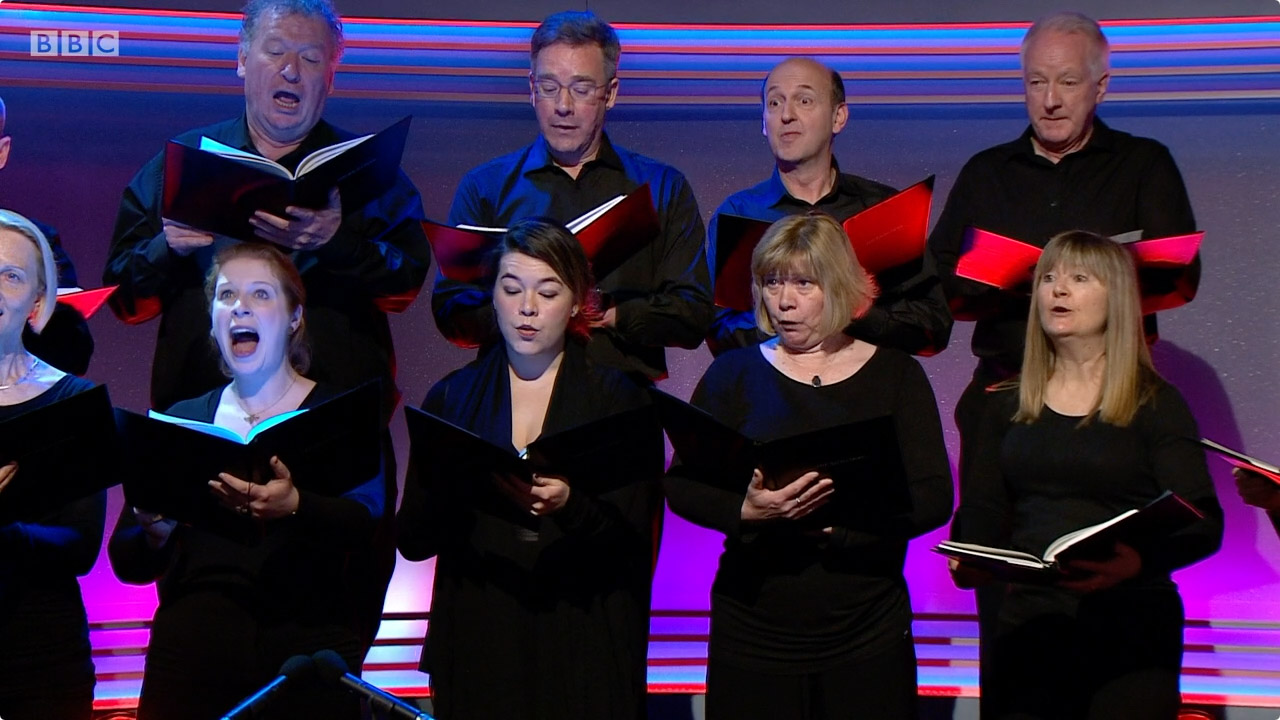Why digital reverb for acoustic music should be believable, appropriate, and seamlessly integrated with the direct sound from the mics

There's a temptation with reverb to try and turn a small recording space into a huge concert hall or auditorium. But it doesn't always work out well.
Sometimes audio is incontrovertibly good, sometimes it is incontrovertibly bad. Sometimes whether a piece of audio is good or bad is a matter of opinion.
Here's a TV studio performance of Handel's Hallelujah Chorus by The Bach Choir, normally 250-strong but here with a select group of eighteen. It's from the BBC's The Andrew Marr Show.
I've left the credits and concert calendar info in at the beginning of the clip in the interests of fair play, but you can skip to the 27 second point if you wish to get straight to the music.
The music is great, the singing is very much to my liking - not too fussy and full of energy. The miking is good too, considering that the studio is small and the engineers are probably all-rounders rather than specialists in classical music.
But the reverb. Oh, the reverb.
This is just my opinion and I fully accept that other people's opinions may differ. But I think that the reverb here is totally unsuitable for a number of reasons.
What's wrong?
I can see the point of the long reverb time and high level of reverb. It simulates the cathedral or large church or concert hall where the choir would normally perform.
But it's the wrong way to go.
Clearly some digital reverb will be useful in a small, probably quite dry, TV studio. But it needs to do three things...
- Create a believable acoustic space
- Create an appropriate acoustic space
- Integrate seamlessly with the direct sound into the mics.
By 'believable' I mean that the reverb should sound real, not artificial. This shouldn't be too difficult with modern convolution reverbs, and it isn't impossible with a careful selection of program and delicate tweaking in an algorithmic reverb unit or software.
Here the reverb is kind of believable. It makes me think of a large space like St. Paul's cathedral in London, where I have recorded. Large spaces with stone surfaces create natural reverb that is high in level and long in duration. Some of the resonances in this clip however, particularly in the low notes of the organ, seem very much larger than real life.
Believable though the acoustic space may be, to an extent, it is far from appropriate. This is TV and we can see the small number of singers, and the small space of the studio. What we hear conflicts massively with what we see. This is a long way from being appropriate.
Making the reverb appropriate means taking into account the ensemble, the nature of the space in which the recording is made, the music, and if it's on TV then what the viewers can see.
The reverb should enhance the existing acoustic space, not obliterate it.
Finally, in this recording there is a huge disconnect between the direct sound from the mics and the reverb. Admittedly this is difficult with close mics. When recording in a pleasant-sounding acoustic space that isn't too small, then balancing the close mics and ambience mics is one of the engineer's arts and crafts. A skilled engineer who specialises in classical music will do this well, and almost instinctively.
But working in a small room does make things more difficult. Working with an inappropriate reverb makes things worse.
So, I'll say again that this is my opinion and I don't want to disrespect anyone involved in this production, or anyone who likes the reverb the way it is. But believability, appropriateness, and integration are always important considerations when adding reverb to an acoustic performance.
P.S. The organ - It's so lovely to hear a real organ, even if small in scale. It is common to replace awkward or unusual instruments with a digital keyboard, but for my money there's nothing quite like the real thing.
Note: You can also add reverb using the natural echo chamber technique...
Comments on this video
You can comment on this video at YouTube
You can comment on this video at YouTube






























